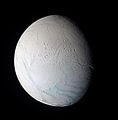Fichier:Enceladus7.25.2005.jpg

Fichier d’origine (960 × 976 pixels, taille du fichier : 65 kio, type MIME : image/jpeg)
Ce fichier provient de Wikimedia Commons. Il peut être utilisé par d'autres projets. Sa description sur sa page de description est affichée ci-dessous.
Description
| DescriptionEnceladus7.25.2005.jpg |
English: As Cassini approached the intriguing ice world of Enceladus for its extremely close flyby on July 14, 2005, the spacecraft obtained images in several wavelengths that were used to create this false-color composite view.
The surface of Saturn's moon Enceladus shows a range of crater ages, including regions that have very few discernable craters at Cassini's resolution. This observation indicates that there have been multiple episodes of activity on Enceladus spread over some fraction of its history. The resurfacing mechanism appears to be dominated by tectonic fracturing. There is no clear evidence yet for release of liquid to the surface in either icy volcanic flows or geysers. The south polar region (seen here at the lower right) has a distinctive tectonic structure that sets it apart from the rest of the satellite. Its outer boundary is marked by a series of pronounced tectonic "gashes" that form a hoop-like boundary, near 60 degrees south latitude. In this image, this fault zone forms the transition region from the presumably older, cratered terrain in the north to the younger, nearly crater-free region in the south. This false-color view is a composite of individual frames obtained using filters sensitive to ultraviolet (centered at 338 nanometers), green (centered at 568 nanometers) and infrared light (centered at 752 nanometers). The view has been enhanced to accentuate subtle color differences and fine-scale surface features. The Sun illuminates Enceladus from the lower left, leaving part of the moon in shadow. This view shows the anti-Saturn hemisphere, centered at 42 degrees south latitude, 167 west longitude. The images comprising this view were taken with the Cassini spacecraft narrow-angle camera at a distance of about 112,100 kilometers (69,700 miles) from Enceladus, and at a Sun-Enceladus-spacecraft, or phase, angle of 46 degrees. The image scale is about 670 meters (2,200 feet) per pixel. The Cassini-Huygens mission is a cooperative project of NASA, the European Space Agency and the Italian Space Agency. The Jet Propulsion Laboratory, a division of the California Institute of Technology in Pasadena, manages the mission for NASA's Science Mission Directorate, Washington, D.C. The Cassini orbiter and its two onboard cameras were designed, developed and assembled at JPL. The imaging team is based at the Space Science Institute, Boulder, Colo. |
| Date | |
| Source | http://photojournal.jpl.nasa.gov/catalog/PIA06249 |
| Auteur | NASA/JPL/Space Science Institute |
Cette image ou vidéo a été cataloguée par le Johnson Space Center de la National Aeronautics and Space Administration (NASA) des États-Unis sous Photo ID : PIA06249.Ce bandeau n’indique rien sur le statut de l’œuvre au regard du droit d'auteur. Un bandeau de droit d’auteur est requis. Voir Commons:À propos des licences pour plus d’informations. Autres langues :
العربية ∙ беларуская (тарашкевіца) ∙ български ∙ català ∙ čeština ∙ dansk ∙ Deutsch ∙ English ∙ español ∙ فارسی ∙ français ∙ galego ∙ magyar ∙ հայերեն ∙ Bahasa Indonesia ∙ italiano ∙ 日本語 ∙ македонски ∙ മലയാളം ∙ Nederlands ∙ polski ∙ português ∙ русский ∙ sicilianu ∙ slovenščina ∙ Türkçe ∙ українська ∙ 简体中文 ∙ 繁體中文 ∙ +/− |
Conditions d’utilisation
| Public domainPublic domainfalsefalse |
| Ce fichier provient de la NASA. Sauf exception, les documents créés par la NASA ne sont pas soumis à copyright. Pour plus d'informations, voir la politique de copyright de la NASA. |  | |
 |
Attention :
|
Légendes
14 juillet 2005
14 juillet 2005
PIA06249
Historique du fichier
Cliquer sur une date et heure pour voir le fichier tel qu'il était à ce moment-là.
| Date et heure | Vignette | Dimensions | Utilisateur | Commentaire | |
|---|---|---|---|---|---|
| Actuel | 5 février 2012 à 03:56 |  | 960 × 976 (65 kio) | wikimediacommons>Huntster | Full size version from source. |
Utilisation du fichier
La page suivante utilise ce fichier :